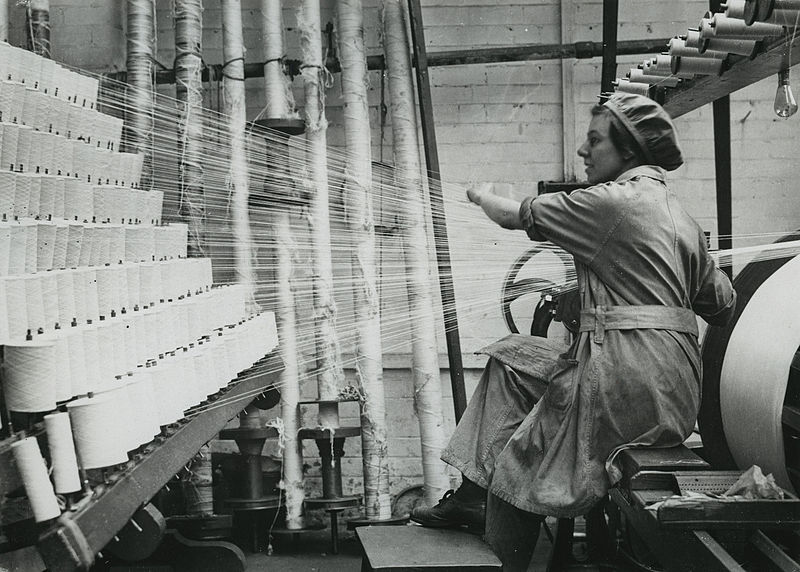Compared to the post-industrial prosperity Americans enjoy today, “sweatshops” seem inhuman.
But there is another side to the story. Strange as it sounds, there are places “where sweatshops are a dream” offering life-transforming wages. Particularly for women.
Factory work has historically offered women an escape hatch from traditional gender roles. During the Industrial Revolution in Europe and the United States, young women fled the impoverished countryside to work at factories in cities where they could earn and spend their own money. Most ceased work after marriage, but for a time they enjoyed a level of independence that disturbed Victorian sensibilities.
Many complained that factory conditions were too dangerous for women. Others feared women living apart from the protection of a father or husband would ruin their reputations—even if they did not actually transgress the mores of the day, they still risked the appearance of impropriety. In 1840, the Boston Quarterly Review’s editor remarked, “‘She has worked in a factory,’ is sufficient to damn to infamy the most worthy and virtuous girl.”
Female factory workers themselves did not all share the view that they were victims of capitalist exploitation and insufficient male protection. That remark about infamy, and others about mistreatment, prompted this response from a textile mill operative named Harriet in Lowell, Massachusetts:
We are under restraints, but they are voluntarily assumed; and we are at liberty to withdraw from them, whenever they become galling or irksome … we are [here] to get money, as much of it and as fast as we can … It is these wages which, in spite of toil, restraint, discomfort, and prejudice, have drawn so many … girls to … factories … one of the most lucrative female employments should [not] be rejected because it is toilsome, or because some people are prejudiced against it. Yankee girls have too much independence for that. . .
Today, the story of the “factory girls” is repeating itself in new settings across the world—both the story of young women gaining economic independence through risk and toil, and the story of widespread panic over their possible exploitation. Consider Asia.
China saw the largest migration in history from rural poverty to urban factories, starting in the 1980s after economic liberalization put an end to communist experimentation. Nearly all of these migrants are under 30, and many factories are majority-female.
Initially, Chinese society viewed factory work as shameful to a woman’s reputation and dangerous, echoing Victorian concerns for the Industrial Revolution’s “factory girls.” But over time, migration became a rite of passage for rural Chinese. Today, urban life affords factory workers—particularly women—freedom from rural areas’ more traditional and restrictive social norms.
Compared to their Industrial Revolution predecessors, China’s “factory girls” enjoy more opportunities for social mobility and long-term labor force participation. They often aspire to white-collar work by learning new skills during off-hours. In fact, as China’s human capital and wages have soared, more workers have moved into the services sector, and many factories have relocated southwards to poorer countries.
Fears of exploitation now often center on South and Southeast Asia. Human Rights Watch recently published a piece condemning Cambodia’s garment factories. True, factory work is difficult and sometimes deadly—just as it was in the Industrial Revolution.
“But ask the woman,” economist Deirdre McCloskey suggests, “if she would rather that the shoe company not make her the offer … Look at the length of queue that forms when Nike opens a new plant in Indonesia. And ask her if she’d rather not have any market opportunities at all, and be left home instead entirely to her father or husband.”
Factory work, though arduous, often represents an improvement for women. Research from Yale University suggests the rise of the garment industry, dominated by female factory workers, helps explain the falling rate of child marriage and rapid increase in girls’ educational attainment in Bangladesh.
Regrettably, well-intentioned calls for export restrictions and boycotts can harm the very women they seek to help, many of whom fear the loss of factory work and a return to rural penury and stricter gender roles. Already, automation threatens the jobs of nine million, mostly young and female, garment factory workers. Boycotts worsen this situation.
Harriet’s arguments still apply today. As long as work is “voluntarily assumed” and laborers maintain the “liberty to withdraw” from it, we should not reject a potential force for women’s empowerment in developing countries in an attempt to protect them. Women everywhere have too much independence for that.
This first appeared in The Hill.

